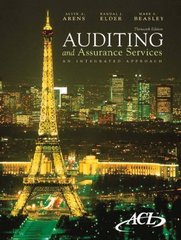Question
Option (a): Overhaul the existing equipment. The following expenses are anticipated under this approach: The normal annual cost for lubrication and replacement of minor parts
Option (a): Overhaul the existing equipment. The following expenses are anticipated under this approach:
The normal annual cost for lubrication and replacement of minor parts to maintain the integrity of the exterior body would be $27,000.
The cost of re-wiring interior components in an overhaul would be $125,000.
Replacing old worn components would cost $82,000 with associated labor costs of $210,000 for installation. The overhaul is estimated to extend the useful life of the equipment another four years past the present useful life was eight years, starting January 1, 2006.
Option (b): Purchase new equipment. Purchase new equipment by giving a non-interest-bearing note with five payments of $164,000 to the supplier (starting on the first day of notes term and each year thereafter) and selling the old equipment for $60,000 cash. The first $164,000 payment would be made in late December 2013. The prevailing interest rate for obligations of this nature is 10%. (Remember this option uses a present value factor of (4.16986) to calculate the Present Value of Asset) (I=10% n=5) =, as the purchase price is not supplied, but requires calculation.
Scenario
Recall that the original cost of the equipment was $440,000 and it was depreciated over an eight-year life. CM2 used the double-declining-balance method to depreciate these assets and estimated a residual value of $50,000. The equipment is now fully depreciated to its salvage value of $50,000.
Going forward, Conner and Martin are questioning the accounting for depreciation. They argue that they don't think it is necessary to record depreciation expense on the income statement because it does not involve a cash outlay. In addition, they do not see the necessity for reducing the equipment value on the balance sheet. They wonder whether CM2 should just stop depreciating its equipment from this point forward.
Action
1. Prepare a short memo to Conner and Martin explaining the merits of using the Accelerated Depreciation method, such as Double-Declining Balance, in the assets' beginning Useful Life and changing to the Straight-Line method in year 3 for the remaining 8 years. In your answer, address the following issues:
Does CM2 benefit from depreciating this equipment using these depreciation methods?
What is the effect on CM2s financial statements with these Depreciation methods?
2. Use a computer spreadsheet to prepare a depreciation schedule for the old equipment over its eight-year life using the Double-Declining Balance for year 1-5 and Straight-Line method for the remaining 3 years. Record the journal entry for depreciation that would be made in the third year of the equipments useful life.
Step by Step Solution
There are 3 Steps involved in it
Step: 1

Get Instant Access to Expert-Tailored Solutions
See step-by-step solutions with expert insights and AI powered tools for academic success
Step: 2

Step: 3

Ace Your Homework with AI
Get the answers you need in no time with our AI-driven, step-by-step assistance
Get Started


